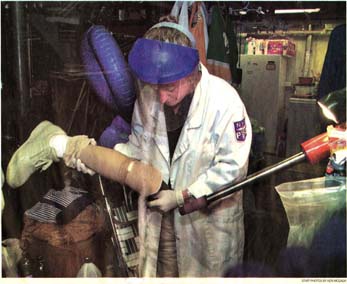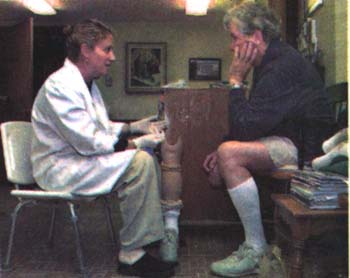


Ingrid Frank, C.P., CMF is an ABC Board Certified Prosthetist, Board Eligible Orthotist, and BOC Certified Mastectomy Fitter. She has successfully completed a four year specialized Bachelor of Science degree program in Prosthetics and Orthotics at New York University, and was the first woman to receive a Bachelor of Science degree in Orthotics and Prosthetics, in 1975. Her certification and background, along with her dedication to continuing education and training, is your assurance of professional standards and high competency. Ingrid Frank is a member in good standing of the AAOP.
When I graduated from New York University’s Prosthetics and Orthotics degree program I was the first woman to do so. I was educated in the latest techniques in the creation of lightweight, highly functional prosthetic and orthotic devices. What I discovered when I got in to the field was that many Prosthetic and Orthotic practitioners were still making heavy metal braces and wooden legs. Additionally, I felt that my patients weren’t always getting the full attention they deserved. Many times I saw patients who I felt could be better served if just a little bit more attention was paid to them and their individual needs. Unfortunately in a large facility this not always possible. As in most medical facilities there was always pressure to get on to the next case. When I started Ingrid Frank Prosthetics in 1982 I decided I did not want to fall in to this trap. Instead, I wanted to keep my business small and personal. I realize that when one of my patients leaves with a brace or prosthetic limb, that device will be become an important part of his or her life. A well made device can mean the difference between a life full of activity and a life of limitations and pain. As a solo practioner, I am never pressured by the management to rush you out the door so I can get on to the next case, because I am the management.
Sincerely,
Ingrid Frank, C.P., CMF
February 2007 article entitled "Five Questions for Ingrid Frank, CP" in the O&P Edge, a site devoted to orthotics and prosthetics news.
The following is an article from the Metrowest Daily News on Tuesday, March 27, 2001, from the Health and Environment section.
 |  |
Left: Ingrid Frank works in her shop in the basement of her Natick home. Right: Frank talks to client Ron Ingalls of Ashland about his prosthetic leg during an appointment in her Natick office.
| |
By Chris Bergeron (News Staff Writer)
NATICK - With a surgeon's precision and a sculptor's craft, Ingrid Frank helps her clients walk again.
Some roll into her Natick home office in wheelchairs and walk out on the prosthetic legs she has fashioned for them.
Thanks to Frank's skill, one customer danced through her wedding on five-inch heels with an artificial foot inside.
Another client spends his weekends golfing, whacking long drives by twisting on an artificial leg she customized.
From her basement office, Frank provides veterans of three wars with prosthetic legs to replace those lost in combat.
The 48-year-old Mom owns and runs Ingrid Frank Prosthetics, Inc., which supplies artificial limbs, braces, and prosthetic breasts so her customers can enjoy their lives as fully as possible.
Often, Frank's ability to customize and fit an artificial limb restores an elderly customer's ability to move about their apartment, walk to the market or go to church.
"Right now there's an elderly man who can't get past the three steps to his apartment until I fit him for an artificial leg," she said.
Frank said some patients are discharged from hospitals after surgical amputations before being fitted for a prosthetic limb which they need to care for themselves.
"Some leave the hospital sitting in wheelchairs," she said.
While many of her clients are elderly and struggling to adjust to life after amputation, Frank said her work constantly reminds her of the human capacity to fight the good fight.
"How could it be depressing if someone comes to you needing help and you're able to give it to them?" she said.
One of the female pioneers in her field, Frank acknowledges she ended up specializing in prosthetics and orthotics, or braces, as a result of a series of "lucky flukes" that influenced her career choice.
"I've always loved art and medicine and people," she said from her basement office at 110 Bacon St.
Born in Pennsylvania, she initially attended Boston University expecting to major in pre-med or biology but temporarily lost her direction as a sophomore.
After studying her strengths and interests, a friendly counselor asked whether she'd be interested in being the first woman to earn a Bachelors of Science in prosthetics/orthotics at New York University. Frank was the first woman accepted in NYU's nine-member, four-year program, a dramatic increase from the two men the year before.
In recent years, the mechanics of constructing artificial limbs has evolved dramatically in technical sophistication and comfort.
"Before, it was more like shoemaking. They had carved wood sockets," she said. "Now, it's more like architecture." Graduating with a B.S. degree in the mid-1970s and also earning her federal certification in 1976, Frank has been one of the few women making artificial limbs over the last 25 years.
Presently, the majority of her patients - as many as 85 percent - are seniors who've lost a leg due to circulatory problems, generally from diabetes.
Frank described her clients as "predominantly geriatrics over 65 years old" who need to replace missing limbs.
She said she doesn't make or fit prosthetic arms because of the mechanical complexity.
But she does fit and customize prosthetic breasts from silicone gel that slip into special bras for women who've had mastectomies.
And Frank also makes special pressurized sleeves for women whose arms swell after lymph nodes are removed during surgery.
In addition, Frank makes braces and supports for clients suffering from multiple sclerosis, cerebral palsy and spina bifida.
Most clients come to her through referrals from physicians, therapists, or insurance companies.
After learning a potential client needs her services, Frank often visits them at their homes for a preliminary interview to address their needs.
"Most are very depressed and feelhopeless. Typically, when I arrive they've been through an emotional wringer. I've got to be a sort of a counselor and psychiatrist," she said.
For Frank, the key to a persons' ability to adjust to wearing a prosthetic leg is often based on their feelings about amputees before losing a limb.
However, she feels that the public has become more accepting of individuals using prosthetic limbs.
Frank said, "I think there's less prejudice now than their ever was. People aren't really looking at other people symmetrically anymore."
Yet, she pointed out that among people with prosthetic limbs, there's less of a tendency to disguise them for purely cosmetic purposes.
And some amputees who use the most expensive or sophisticated prosthetics, such as a $14,000 artificial leg, wear them publicly and proudly as "a status symbol."
Frank said being an amputee has lost much of its social stigma, pointing out that celebrities such a disc jockey Dick Clarke and the fiancée of Paul McCartney of the Beatles wear artificial limbs.
Since federal law prohibits reuse of any parts of prosthetic limbs, Frank forwards all components or models returned to her to an organization that distributes them among the needy in impoverished Third World countries.
Frank said "getting used to moving about with help from an artificial limb takes a period of adjustment, up to six months."
But after more than two decades helping amputees get back on their feet, she's tough-minded enough to say "If people are going to feel sorry for themselves, it's not going to do anybody any good."
Patients whose knee remains after surgery "are in pretty good shape," as they still have a natural limb joint of enormous complexity, but she also caters to those who have lost this critical joint in an amputation.
"It's like learning to ride a bicycle," she said.
But when a patient has lost a leg above the knee, Frank explained that training them to walk often requires a rather arduous discipline of teaching them to shift their weight so the artificial limb will "walk" properly in step with them.
"It's not a picnic. It involves hard work. When they go home I have them practice standing at their sink and making the necessary movements," she said.
Contrary to popular opinion, Frank said young children who've lost their limbs often make the best adjustments to using prosthetic limbs because of their youthful fitness and adaptability.
Yet, she often refers younger clients to the Shriners Institute or Children's Hospital because "it's best for them to be around other young kids."
Preparing leg and back braces represents another aspect of Frank's work.
She said braces are "corrective and supportive" devices used "predominantly to restore the function of an injured limb or muscle group."
Frank does most of her customizing in a basement workshop where she uses a $14,000, six-foot tall machine to help her buff and grind the varied components of clients' prosthetic limbs.
She explained that custom-fitting a prosthetic limb so it will not irritate the remaining stump often involves making a plaster cast that shows particularly sensitive areas or nerve endings.
Frank said the technical aspect of the work satisfies her artistic side because it involves the manual skills and imaginative vision that initially attracted her to art.
But, there's also satisfaction of a more lasting type.
"It makes me happy," Frank said. "Every day I watch people who came here in wheelchairs walk out on their own."
© Ingrid Frank Prosthetics Inc. -- ingridfrankprosthetics.com 2005-2009
Contact us at ingrid@ingridfrankprosthetics.com or at (508) 655-6698
Webmaster: Jon Frank